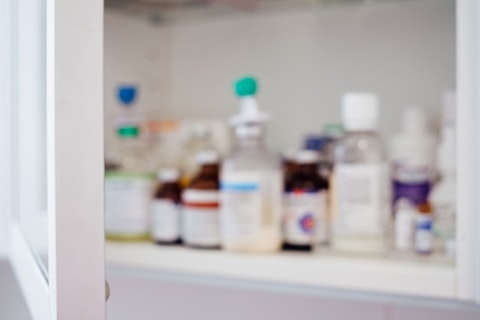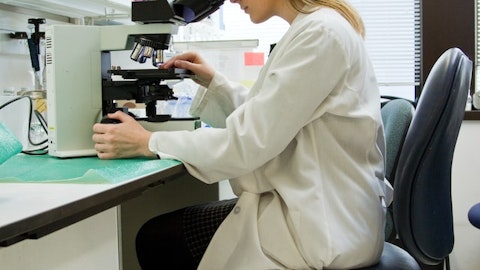Jazz Pharmaceuticals plc (NASDAQ:JAZZ) Q4 2022 Earnings Call Transcript March 1, 2023
Operator: Good day, and welcome to the Jazz Pharmaceuticals Fourth Quarter and Full Year 2022 Financial Results Call. At this time, all participants are in listen-only mode. After the speakers’ presentation, there’ll be a question-and-answer session. Instructions will be given at that time. As a reminder, this call is being recorded. I would now like to turn the call over to Darren Fox, Executive Director of Investor Relations. You may begin.
Darren Fox: Thank you, operator, and good afternoon, everyone. Today, Jazz Pharmaceuticals reported its fourth quarter and full year 2022 financial results. The slide presentation accompanying this webcast is available on the Investors section of our website. Investors may also refer to the press release we issued earlier today, which is also posted on our website. On the call today are Bruce Cozadd, Chairman and Chief Executive Officer; Renee Gala, Executive Vice President and Chief Financial Officer; Dan Swisher, President and Chief Operating Officer; and Rob Iannone, Executive Vice President, Global Head of R&D. Kim Sablich, Executive Vice President and General Manager, United States, will join the team for Q&A. On Slide 2, I’d like to remind you that today’s webcast includes forward-looking statements, such as those related to our future financial and operating results, growth potential and anticipated developments and commercialization milestones and goals, which involve risks and uncertainties that could cause actual events, performance, and results to differ materially from those contained in these forward-looking statements.
We encourage you to review the statements contained in today’s press release, in our slide deck, and in our latest SEC disclosure documents, which identify certain factors that may cause the company’s actual events, performance, and results to differ materially from those contained in the forward-looking statements made on today’s webcast. We undertake no duty or obligation to update our forward-looking statements. Turning to Slide 3. On this webcast, we will discuss non-GAAP financial measures. Reconciliations of GAAP to non-GAAP financial measures are included in today’s press release and the slide presentation available on the Investors section of our website. I’ll now turn the call over to Bruce.
Bruce Cozadd: Thanks, Darren. Good afternoon, everyone, and thank you for joining us today. I’m excited to share our strong fourth quarter and full year results, capping off an outstanding year of performance and execution for Jazz, providing us with significant momentum as we enter 2023 and continue to drive towards Vision 2025. I’ll start on Slide 5. This year, Jazz is celebrating its 20th anniversary. Over those 20 years, we remained focused on our purpose of improving the lives of patients and our commitment to being a great place to work, while delivering consistent top-line growth. In 2022, we’ve built on that foundation of strong execution, achieving record revenue, advancing multiple therapies in our pipeline and adding several exciting molecules through corporate development, all while remaining focused on disciplined capital allocation and operational excellence.
All of these accomplishments, contributed to the ongoing transformation of our business to a high-growth global biopharma leader and position us well to achieve Vision 2025. Vision 2025 includes three components central to driving sustainable growth and enhanced value as we transform our company: commercial, pipeline and operational excellence. I’ll now highlight several of our accomplishments in each of those areas in 2022, starting with commercial. Based on our strong commercial performance, we continued to deliver significant revenue growth. In 2022, we recorded $3.7 billion in revenue, which represented an 18% increase compared to 2021. Our top-line growth was driven by the continued success of three recently launched products, Xywav, Zepzelca, and Rylaze, along with strong growth for Epidiolex.
Xywav is now our largest product by revenue, annualizing at more than $1 billion. Based on our outstanding commercial execution, we achieved our 2022 total revenue guidance as well as guidance for each of our Neuroscience and Oncology franchises. Moving to the pipeline, we continue to advance our clinical portfolio and added three exciting new molecules to our pipeline during 2022. Within the past three months, our most recent Oncology pipeline addition, zanidatamab, has had positive data readouts in both of its initial target indications. Over the course of the year, we initiated seven new clinical trials, submitted four new INDs, generated multiple important datasets, and received regulatory approval for an important update to Rylaze dosing.
Our pipeline has never been as robust or productive as it is right now and we have multiple value inflection points over the next 12 to 24 months. On operational excellence, our continued focus on disciplined capital allocation and operating efficiency drove a 2022 adjusted operating margin of 48%, which represents a substantial increase from the 43% we recorded in 2021. We significantly reduced our net leverage ratio and continued to diversify our revenues in 2022, while also executing multiple strategic transactions that we believe will create sustainable value for patients and shareholders. These achievements on both the top- and bottom-line enabled us to significantly increase our operating cash flow and financial strength. We generated $1.3 billion in cash from operations and the overall health of our balance sheet is enabling us to be active in pursuing additional corporate development opportunities.
Turning to Slide 6. We’ve made substantial progress since introducing Vision 2025 last January, and we remain focused on our transformation to a high-growth global biopharma leader. Our many accomplishments in 2022 have positioned us well for 2023. Despite the recent introduction of an authorized generic of Xyrem, which until recently was the company’s largest product by net sales, we are entering the year with an expectation of achieving top-line revenue growth in 2023 and remain confident in our ability to achieve the important milestones underpinning Vision 2025. I’ll now turn the call over to Dan for an overview of our commercial performance, after which Rob will share an update on progress across our R&D programs. Renee will then provide a financial overview, which will include a discussion of our 2023 guidance in addition to 2022 performance.
We’ll then open the call to Q&A. Dan?
Dan Swisher: Thanks, Bruce. I’m excited to share the continued progress across our commercial portfolio. I’ll start on Slide 8, with Neuroscience and oxybate. As a leader in sleep medicine, we believe the approval of Xywav in mid-2020 marked a meaningful advance in patient care. As the lower-sodium oxybate, Xywav has offered patients with narcolepsy and IH, who are taking a lifelong therapy to address their sleep disorders, a way to reduce sodium intake which is a known risk factor for cardiovascular disease. In the fourth quarter, average active oxybate patients increased to approximately 18,000, representing growth of approximately 11% compared to the same period last year. There were approximately 10,300 active Xywav patients exiting the quarter, resulting from strong adoption in both narcolepsy and IH.
Over the course of 2022, this compelling adoption continued to reinforce our confidence in the durability of Xywav, and we expect Xywav to grow and remain the oxybate of choice in 2023. As Bruce noted, Xywav became our largest product in net sales in the fourth quarter ’22, annualizing at more than $1 billion and on track to achieve blockbuster status in 2023. We continue to see robust uptake of Xywav for narcolepsy in the fourth quarter and we exited the quarter with approximately 8,550 narcolepsy patients taking Xywav. There are now more narcolepsy patients on Xywav than Xyrem, indicating our sodium messaging is resonating with healthcare providers and patients. In addition to adoption of Xywav among current Xyrem patients, the large majority of new to oxybate narcolepsy patients are being prescribed Xywav.
Xywav is the first and only FDA-approved therapy for IH, and we’re continuing to see increased enthusiasm among physicians for identifying appropriate patients and initiating therapy. Exiting the fourth quarter, there were approximately 1,750 IH patients taking Xywav. We remain focused on educating prescribers and patients about the compelling efficacy and established safety profile of Xywav and are confident in our ability to maximize Xywav’s potential in this underserved market. I also want to comment on the evolving landscape for oxybate. In January 2023, an authorized generic to Xyrem was launched. We expect that Xywav will both grow and remain the oxybate of choice in 2023 even with one or more authorized generics on the market and branded competition potentially entering the marketplace this year.
Xywav remains the only lower-sodium oxybate available to patients and we expect it to be the only oxybate indicated for IH for the foreseeable future. FDA has recognized Xywav as clinically superior to Xyrem by means of greater safety. In addition, we have orphan drug exclusivity that extends to 2027 for narcolepsy and 2028 for IH, as well as Orange Book-listed patents that extend out to 2033. All of these factors give us confidence that Xywav is a durable product that will continue to be a core growth driver for Jazz. Turning to Slide 9, and Epidiolex. Net product sales grew by 7% in the fourth quarter and 12% for the full year 2022, compared to the same periods in 2021 on a pro-forma basis, with growth driven primarily by underlying demand.
Now that we’re several years out from lunch, we have visibility into seasonality trends. Inventory typically builds over the course of the second half of the year, which results in lower revenues in the first half. Our success in growing Epidiolex this year has been driven by a number of factors, including increased access to treatment centers and physician offices, leading to more face-to-face interactions. Given the promotionally sensitive nature of Epidiolex and the anti-epilepsy market as a whole, greater access to HCPs has been a key driver. We continue to add new prescribers, our volume of engagement with HCPs is increasing, and our market research indicates nearly 60% of prescribers are moving Epidiolex up in the treatment algorithm, all positive indicators for continued growth.
There has been continued adoption of Epidiolex in ex-U.S. markets. With the recent launch in France, Epidiolex is fully reimbursed and commercially available in all five major European markets. We remain excited about the future growth in blockbuster potential of Epidiolex. We are confident that this that with its unique mechanism of action and ability to be combined with other therapies along with increasing positive experiences in real-world settings, Epidiolex can become standard of care in treatment-resistant epilepsies and achieve blockbuster status. Now moving to Slide 10, and Zepzelca. We have rapidly established Zepzelca as the treatment of choice in second-line small-cell lung cancer, achieving $607 million in revenue sense launch in mid-2020.
Year-over-Year revenue growth was 11% and 9% for the fourth quarter and full year, respectively. We have multiple ongoing efforts to further expand market share in the second-line setting by investing in real-world evidence and observational studies that we believe will generate additional data around Zepzelca’s utility in a broad range of second-line small-cell lung cancer patients. Our robust development program, which Rob will outline in more detail shortly, is exploring the utility of Zepzelca in several new patient populations. Our nearest-term opportunity for meaningful growth comes from the potential of Zepzelca to be used in first-line treatment of small-cell lung cancer. We also have trials assessing the efficacy and safety of Zepzelca in other tumor types.
As highlighted on Slide 11, the Rylaze launch has been incredibly successful with $367 million in revenue since launch in mid-2021, including 25% revenue growth in the fourth quarter of 2022 compared to the same period in 2021. Rylaze remains the only therapy available to patients in the U.S. who have a hypersensitivity reaction to E. coli-derived asparaginase. It has been adopted universally in pediatric oncology protocols and having solved for the supply constraints for non-E. coli-derived asparaginase. Healthcare professionals are reporting that they are returning to best clinical practice and switching ALL and LBL patients to Rylaze earlier when there has been an initial hypersensitivity reaction observed. We are encouraged to see that there is increasing use of Rylaze in the treatment of adolescents and young adults, a potential growth driver for 2023.
To summarize, we are continuing to execute incredibly well on commercial and are maintaining the momentum to successful launches for our key products. Now, I will turn the call over to Rob for an update on our pipeline progress in 2022 and milestones for 2023. Rob?

Photo by freestocks on Unsplash
Rob Iannone: Thanks, Dan. In recent years, we have enhanced the breadth and depth of our pipeline, as well as our R&D capabilities. Our acquisition of GW in 2021 accelerated that process and, in 2022, we added three promising candidates to our pipeline: zanidatamab, a novel late-stage oncology asset; JZP441, an orexin-2 receptor agonist for which we initiated a Phase 1 clinical program in 2022; and JZP898, a differentiated conditionally-activated interferon alpha INDUKINE molecule that will be entering the clinic later this year. Starting on Slide 13, I’ll highlight the most recent addition to our pipeline, zanidatamab, a novel HER2-targeted bispecific antibody with biparatopic binding and the potential to transform the current standard of care in multiple HER2 expressing cancers.
As an oncologist, I’m impressed to see monotherapy activity with zanidatamab across multiple HER2 expressing tumor types, including cases resistant to prior HER2 therapies. Based on its potential to benefit patients across multiple tumor types, we are committed to advancing this program as rapidly as possible. The most advanced clinical work with zanidatamab is in biliary tract cancer, or BTC, and metastatic gastroesophageal adenocarcinoma, or GEA. These are cancers with significant unmet need and poor outcomes with current standards of care. Our confidence in zanidatamab has only grown based on positive data in both of these settings. Continuing on to Slide 14, we were very encouraged by the positive top-line results from the recent pivotal trials of zanidatamab in BTC and the first overall survival data for zanidatamab from the Phase 2 first line GEA study.
In December, our partners Zymeworks announced positive top-line results from a pivotal Phase 2b open-label single-ARM clinical trial called HERIZON-BTC-01, evaluating zanidatamab as monotherapy in patients with previously-treated HER2 amplified and expressing BTC. In the trial, 41% of these patients with HER2 amplified and expressing disease achieved an objective response as assessed by a blinded independent central review. The median duration of response at the time of data cut-off was 12.9 months. By contrast, standard of care chemotherapy in second-line BTC would be expected to have an objective response rate of less than 10%. The safety profile of zanidatamab in the trial was consistent with that observed in previously reported monotherapy studies.
Currently, there are no HER2-targeted therapies approved for the treatment of BTC, and we plan to discuss the potential regulatory path forward for zanidatamab in BTC with the FDA. In January, at the ASCO GI conference, the first overall survival data for zanidatamab were presented from a Phase 2 trial, evaluating zanidatamab in combination with chemotherapy and first-line patients with HER2 expressing metastatic GEA. The preliminary results showed that zanidatamab in combination with chemotherapy is a highly active treatment regimen with the ability to generate significant and durable responses. At the time of the analysis, the median overall survival had not yet been reached, with a median duration of study follow-up of 26.5 months. The 18-month overall survival rate was 84%.
The overall survival findings in this trial are compelling, given the historically reported overall survival rate for the currently approved standard of care has a median of 14 months. These results show zanidatamab’s potential as a foundational treatment in patients with HER2 positive GEA and we look forward to additional data from the ongoing pivotal Phase 3 GEA trial, expected to readout in 2024, which may support U.S. and global regulatory filings. Importantly, ongoing research efforts on zanidatamab will inform development and indications beyond BTC and GEA. Turning to Slide 15, we’ve detailed key clinical programs in our pipeline. Starting with Neuroscience. We have initiated a Phase 2 trial for the treatment of Parkinson’s disease tremor with JZP385 or suvecaltamide.
This is in addition to our ongoing Phase 2b trial in essential tremor for which we anticipate top-line data in the first half of 2024. For JZP150, enrollment is ongoing in our Phase 2 PTSD trial with top-line data expected later this year. In 4Q 2022, we initiated our Phase 1 program for the orexin-2 receptor agonist JZP441. And there are currently healthy volunteer trials in the clinic. We anticipate initial proof-of-concept in healthy volunteers this year. Moving to Oncology, as Dan mentioned, we are continuing to execute our robust development efforts for Zepzelca. This includes an ongoing Phase 3 trial in collaboration with Roche to evaluate Zepzelca in combination with Tecentriq in first-line extensive stage small-cell lung cancer. A confirmatory Phase 3 trial in second-line small-cell lung cancer being run by our partner PharmaMar in our post-marketing observational trial in second-line small-cell lung cancer.
We’re also exploring Zepzelca in other solid tumors in a Phase 2 basket trial. With respect to our supplemental BLA submission for an IV formulation of Rylaze, we have received a complete response letter from the FDA requesting additional clinical data and the IV administration of Rylaze. I want to stress there is no impact on the approved product labeling for Rylaze intramuscular administration. We are currently evaluating a CRL to determine the next steps. Our Marketing Authorization Application submission for JZP458 to the European Medicines Agency is currently under review with potential for approval in 2023. We are also advancing our program in Japan for potential submission, approval and launch. While not listed on this slide, I’ll also note that in October, we initiated our Phase 1 clinical trials for JZP815, our pan-RAF inhibitor for the treatment of solid tumors that have mutations in the MAP kinase pathway.
The pan-RAF inhibitor program is part of a novel class of next-generation precision oncology therapies that has the potential to benefit cancer patients with high unmet needs in multiple different solid tumors. Also, recruitment is expected to begin shortly for our first clinical trial of JZP541, a cannabinoid from the GW platform, assessing its utility in treating irritability associated with autism spectrum disorder in adults. In summary, with the initiation of multiple clinical trials in 2022, we continue to expand our pipeline into disease areas with significant unmet patient need that provides strong opportunities for long-term sustainable growth. We expect to submit several investigational new drug applications throughout 2023. Increased investment, upcoming catalysts, and expanded capabilities in R&D give us confidence in our ability to deliver sustained long-term value to both patients and shareholders.
Now, I’ll pass the call off to Renee for a financial update. Renee?
Renee Gala: Thanks, Rob. I’ll start with our top-line results on Slide 17. As a reminder, our full financial results are available in our press release and 10-K. In 2022, we recorded significant year-over-year revenue growth of 18%, driven by our key products in both Neuroscience and Oncology. We achieved $3.66 billion in revenues for the year and almost $1 billion in revenues in the fourth quarter. Launching multiple products over the past three years, coupled with the acquisition of GW Pharmaceuticals, has enabled us to successfully diversify our revenue, meeting our 2022 diversification target of 60% to 65% of net product sales coming from products launched or acquired since 2019. Given our expectations regarding the durability and growth potential of these products, along with our continued focus on adding new products through corporate development, we believe we are well-positioned to achieve our Vision 2025 goal of $5 billion in revenue.
Turning to Slide 18. Our disciplined capital allocation and focus on operational excellence drove adjusted net income of $934 million, which includes $444 million of IPR&D expense related to corporate development. Contributing to IPR&D were upfront payments for key pipeline additions such as zanidatamab and JZP441, which have the potential to create sustainable long-term value for our company. Our efforts to improve adjusted operating margins to 48% in 2022 have given us additional flexibility to invest in our business and contributed to our significantly enhanced cash generation. In 2022, we generated almost $1.3 billion in cash from operations, an increase of $493 million, or 63%, compared to 2021. On Slide 19, we’ve highlighted our success in rapidly delevering our balance sheet following the GW transaction.
By delevering two full turns since the deal closed in May of 2021, which we accomplished through both debt reduction and enhancing our adjusted EBITDA, we achieved our deleveraging target six months ahead of schedule. We exited the year with an adjusted net leverage ratio of 2.9 times, which reflects cash outflows of $375 million in the fourth quarter to fund the zanidatamab transaction. Our delevered balance sheet and strong cash flow position us with continued strategic flexibility to invest in our current business as well as corporate development opportunities. Our revenue guidance for 2023, outlined on Slide 20, reflects our confidence in the durability of our oxybate franchise and our expectations for continued growth across key products.
Our 2023 guidance for Neuroscience of $2.675 billion to $2.825 billion encompasses our growth expectations for both Xywav and Epidiolex, and the continued decline in Xyrem due to strong Xywav adoption, authorized generics of Xyrem, and potential competition from an additional high-sodium, branded oxybate. For simplicity, our Neuroscience guidance also includes AG royalties, which will be recognized within total revenues under royalties, not under Neuroscience net product sales. Due to the royalty structures within our AG agreements, we expect our royalties to be higher in the second half of 2023 relative to the first half. We remain confident in the durability of our oxybate business now led by lower-sodium Xywav, which is our largest product by net sales and is expected to generate more than $1 billion in net sales in 2023.
Our Oncology guidance of $950 million to $1.05 billion with a midpoint of $1 billion reflects expectations of continued double-digit growth for this franchise, driven by the expected performance of Rylaze and Zepzelca. Our total revenue guidance range for 2023 is $3.675 billion to $3.875 billion, positioning us for total revenue growth year-over-year. Turning now to OpEx and the bottom-line on Slide 21. Our SG&A guidance of $1.045 billion to $1.105 billion is a reduction compared to 2022. As we continue to focus on operational excellence and our operating margin, we are gaining greater leverage from our global footprint and commercialization expenses. Our R&D guidance of $675 million to $725 million represents enhanced investment over 2022, reflecting the growth and maturation of our pipeline.
In 2023, we’ll be investing in a robust pipeline with 23 novel candidates across Neuroscience, Oncology and Cannabinoids, representing 4 times the number of projects we had in 2015. At the midpoint of our guidance, we’ll be investing approximately 19% of revenue into R&D, which is indicative of our continuing transformation. Assumed in this spend are the zanidatamab and Zepzelca clinical programs, later-stage trials for suvecaltamide in both essential tremor and Parkinson’s disease tremor, JZP150 in PTSD as well as earlier-stage trials for Neuroscience programs like JZP441, and Oncology programs such as JZP815 and JZP898. As Bruce and Rob noted earlier, we have key value inflection points in 2023 and 2024 that have the potential to create meaningful long-term value.
On the bottom-line, we expect to continue to deliver strong adjusted net income with 37% growth at the midpoint and a guidance range of $1.24 billion to $1.31 billion. The midpoints of our financial guidance imply an adjusted operating margin of approximately 46% for the year. We’ll continue to prioritize commercial, R&D, and business development efforts that we believe will deliver the most value, leveraging our strong cash generation to invest in our business, improve our bottom-line and continue to deliver strong shareholder returns. Looking ahead to 2023, with our strategic investments, expanding product portfolio, R&D progress and focus on operational excellence, we believe we are well-positioned to achieve Vision 2025 and deliver further diversification, sustainable growth and enhanced value to patients and shareholders.
I’d now like to turn the call back to Bruce.
Bruce Cozadd: Thanks, Renee. I’ll conclude our prepared remarks on Slide 23. 2022 was a transformative year for us. We achieved strong double-digit revenue growth and improved our operating margin significantly. Our commercial teams demonstrated strong performance across our portfolio. We’re confident that Xywav will remain the oxybate of choice in 2023, entering the year with blockbuster status. We expect growth for Epidiolex, and that our Oncology franchise will continue to deliver. Our R&D organization has reached new levels of productivity and expanded its capabilities. We added three new molecules in 2022 and have trials for multiple products underway ranging from potentially pivotal trials to early-stage studies. We are employing greater discipline in our capital allocation strategy, which is aimed at the highest priority areas, including R&D programs and corporate development.
With our strong cash flow, balance sheet and adjusted operating margins, we have the flexibility to make significant investments across commercial, R&D, and corporate development to drive sustainable growth and enhanced value. We’re excited about building on our current momentum in 2023 and expect growth across our key products. Vision 2025 provides a clear perspective on what we expect to achieve in the coming years. We’re excited about the future and what we can deliver to patients and shareholders. I look forward to updating you on our progress as we advance. That concludes our prepared remarks. I’d now like to turn the call over to the operator to open the line for Q&A.
See also 11 Most Profitable Energy Stocks and 25 Largest Energy Companies by Market Cap.
Q&A Session
Follow Jazz Pharmaceuticals Plc (NASDAQ:JAZZ)
Follow Jazz Pharmaceuticals Plc (NASDAQ:JAZZ)
Operator: Thank you. Our first question comes from Jessica Fye with J.P. Morgan. Your line is open.
Jessica Fye: Great. Thanks so much for taking the questions. Ideally two if you can. First, can you talk about how Xyrem dynamics are playing out relative to your expectations since the authorized generic entered? And second, understanding you’re no longer guiding by product franchise here, can you speak a bit to your expectations for Epidiolex growth? Is it possible that growth for that business accelerates in 2023 relative to ’22 with just increasing ability to be in the office, et cetera? Thank you.
Bruce Cozadd: Thanks, Jess. On your question about Xyrem, let me first just put this in context. Our major focus for 2023 and going forward is growing Xywav, both in narcolepsy and idiopathic hypersomnia. That’s been our focus. We’ve had competition for Xyrem for the past couple of years, it’s been us with Xywav, and we’ve seen Xyrem sales coming down. As to what we’re seeing with the AG, maybe I’ll ask Kim to give a couple of thoughts on our experienced thus far in ’23, although we’re obviously not reporting first quarter results right here. And then, maybe Kim, you could just transition right into Epidyolex growth in dynamics there.
Kim Sablich: Sure, Bruce. Happy to do that. As Bruce said, it’s really too early here in the early stages, it’s a comment on the overall impact of the AG on Xyrem, and as he said, our focus does remain on Xywav. And we’re feeling that we’re going to continue to expect in 2023 continued strong uptake of Xywav in both narcolepsy and IH with continuing transition of narcolepsy patients from high-sodium oxybate, either that being Xyrem or later on from the AG over to Xywav based on its differentiation as the only lower-sodium oxybate product. So as a result, we also continue to expect that Xywav will both grow and remain the oxybate of choice in 2023 even with one or more authorized generics on the market and potentially branded competition entering later on in the year.
So overall, our guidance includes continued decline in Xyrem, both due to strong Xywav adoption and the AG entry and potential competition, and we feel very optimistic about the ability of Xywav to continue to grow through 2023. In terms of Epidiolex and the question about whether or not it can accelerate, what I’ll basically say is that we’re continuing to be very pleased with the Epidiolex net product sales and that it increased 12% on a pro forma basis in 2022 compared to 2021, and that we’re very pleased that this has been driven primarily by demand. We’re continuing to add new prescribers still to our active prescriber base, and our overall engagement, as Dan said, of HCPs continues to grow, which is really positive for this product at very promotionally sensitive market.
Dan also mentioned the driver of 60% of prescribers now indicating to us that they’re using Epidiolex even earlier in the treatment algorithm. Heading into 2023, we are — we’ve got a new push in terms of payer coverage. We’ve talked for several years about the payer coverage being quite strong from a quantitative standpoint for patients, but we’re really pleased that our contract-attracting efforts of last year really has paid off and that we’re entering 2023 in an even stronger position with payers. We’ve seen several plans reduce at the start of 2023, their utilization management criteria, ultimately making it a bit easier for HCPs and patients to get access to Epidiolex. And then, we’re going to continue to promote the synergistic effect of using Epidiolex in combination with clobazam.





